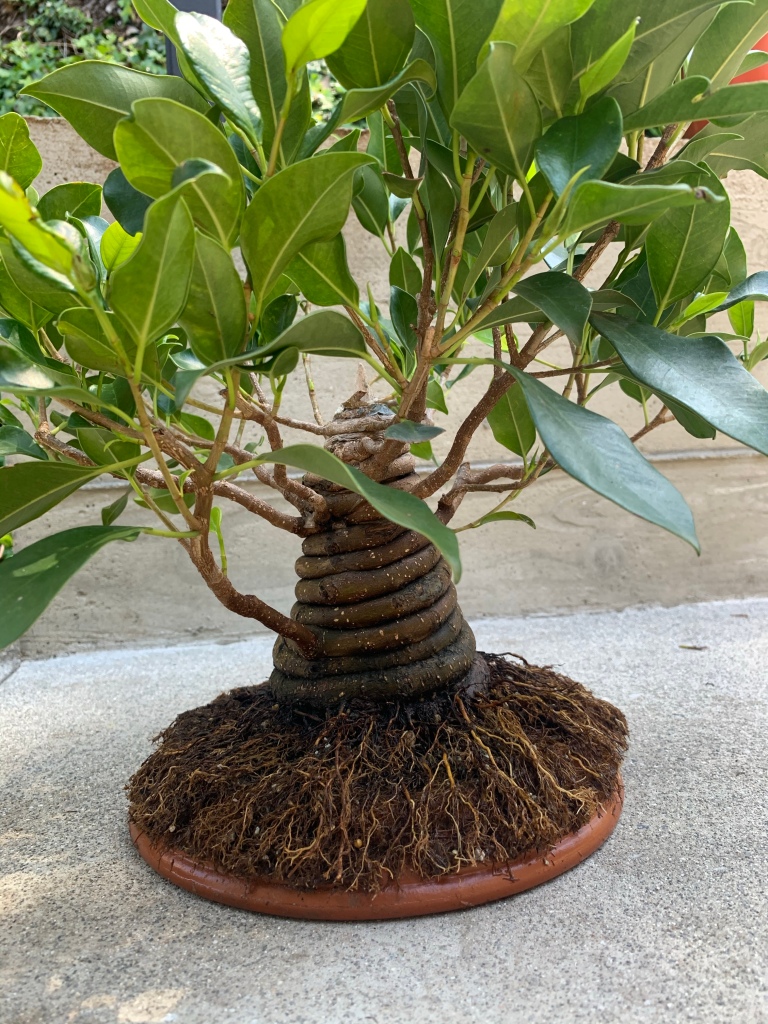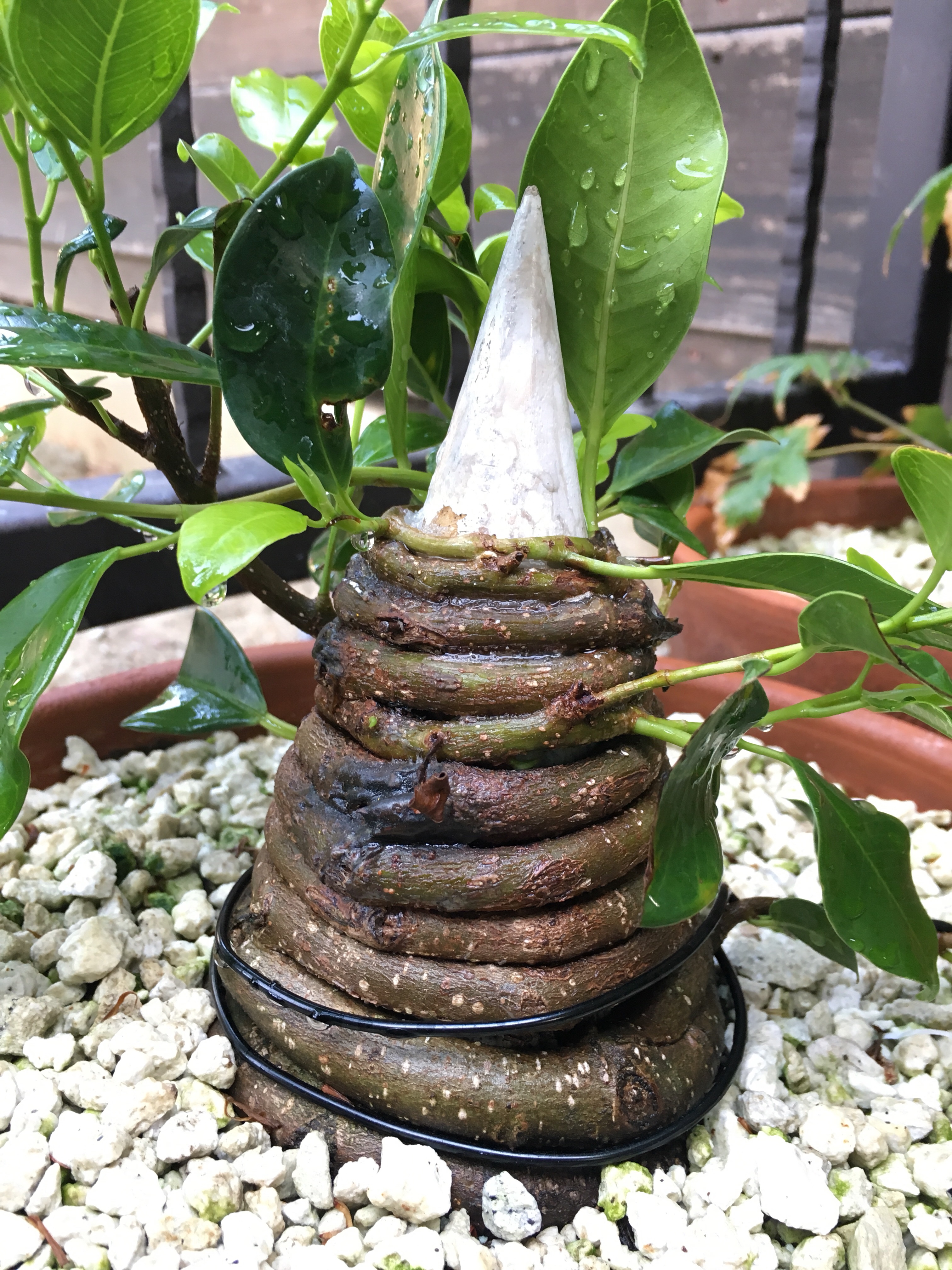
-
Recent Posts
Archives
Blogroll

Posted in Uncategorized
As it’s winding its way to the top of the cone I’m starting to rely on gel Gorilla Glue instead of nails, and winding it before the leader gets woody. I’m still not exactly sure how I’m going to terminate the apex (at the top).
Also wired the first (maybe) permanent branch.


Posted in Uncategorized
… at least on my maples. Zelkovas are usually slower. Took the opportunity over the long weekend to chop some trunks and replant.
Small Zelkova started from seed. It’ll be a root-over-rock:
Trident maple from an air layer. Roots need some work. Hoping for an informal upright:
Green Japanese maple. This needs a lot of root attention. Planted in dirt mix, and once the buds break and it starts growing plan to put rigid plastic around the trunk on the dirt, a zip tie at the base, a collar cut around the cambium along with some rooting hormone, and then pumice on top of the plastic and soil:
Same things as above on this Japanese maple;
Zelkova; this one’s roots are good, though:
Posted in Uncategorized
I have several Zelkovas that I started from seeds a number of years ago. This one was selected for its straight trunk, and I air layered it and placed a plastic lid just under the layer to promote straight roots. Planted in pumice (only), and the results are looking good:
Cleaned the roots. I also cut the trunk below the roots (left from the air layer) after this was taken, and drove a stainless screw through an upside-down terra cotta saucer into the base of the trunk to hold it steady:
You can see the saucer here with the roots splayed over it. After I sawed the initial trunk chop, I used a razor to cut a smooth edge at the cambium, and used a Dremel bit to hollow out the center of the trunk a little. Also used cut rubber hose and tightened a hose clamp near the cut, as this species is supposed to bulge when the buds grow at the edge of the chop:
More pumice and a little cut paste; that’s a wrap:
Posted in Uncategorized
Around and around it goes …

With the tighter circumference as the leaders get to the top, I’m having to coil them when they’re younger and greener. I also made the decision to pick the stronger leader and end the weaker one since the weaker one was making it harder to work with.
I don’t know what I’m going to do once it reaches the top of the cone. It won’t fuse unless it’s allowed to keep growing and expanding. I’m guessing I’ll need to address that sometime in 2018. Any ideas?
Posted in Uncategorized
Happy about the root development since the last post. Applying more rooting gel in voids around the base helped make the roots more even. Trunk is also starting to fuse a little bit:
Posted in Uncategorized
In September 2016 I removed the plant, made some horizontal cuts in the bark on the coil nearest the bottom (closest to the tile), and dabbed-in some rooting gel in the wounds.
Planted it upright with pumice nice and high to allow plenty of coverage (and some moisture)–all tidy: 


As you might also be able to see above, I decided to wrap two branches/trunks around the cone instead of the single leader that I had been doing to this point. The thinking here is that double the branches might mean double the places where backbudding will occur later when I want to focus on growing branches.
For now, though, it’s all about the trunk. Fast forward to the end of January 2017 …
Today I pulled the plant out of its pot, which by the way is so wonderfully easy (and clean) when you have only pumice for soil. I wanted to see how the root formation on the coils had progressed over the past three-to-four months.
Pretty well, I think, considering it’s “winter” here in coastal Southern California:
Nice and flat along the tile, too, just as planned. Oh, and this Clonex rooting gel is amazing! Roots appeared everywhere that I applied it.
The roots are definitely radiating out from the trunk at an angle:
 In other circumstances this might bother me, but I think I’m going to just roll with it here. It definitely stays true to the coiled concept, anyway. All these roots might fuse together, anyway, which could be interesting.
In other circumstances this might bother me, but I think I’m going to just roll with it here. It definitely stays true to the coiled concept, anyway. All these roots might fuse together, anyway, which could be interesting.
You may recall from earlier posts how I zip-tied the original cutting to the tile through two drilled holes: 
This is what it looked like today: 
And a close up of the zip tie area: 
If I were to do this over again, I would just thread a ficus cutting through a hole in the tile close to the cone. Anyway …
Since the roots are looking so good, it was time to separate the original trunk and roots 
I applied more rooting gel on the coil above the cut so roots will cover where the trunk was cut below. I also applied more gel on the cut area. We’ll see what happens there:
Buh-bye: 
Placed deep again in the pot:

Covered it up again, placed the pot in some bright shade, watered; now we wait. I’ll probably wait until summer to dig it up again.
Posted in Uncategorized
I have been using this 3-in-1 product by Bayer to fight the leaf spot, and it’s worked wonderfully on all of my Ficus Microcarpa. It’s also fixed fungal issues I had been having with my Trident Maples over the past several years. I hate to use chemicals, but sometimes …
Healthy growth has allowed me to wrap one more coil around the wooden cone. Because the trunk is still too small for a nail, I’ve just secured it with stretchy garden tape for now … 

Once the weather heats up here in Southern California this thing should progress really quickly.
Posted in Uncategorized
Getting some new growth now that spring is here. Hopefully the leaf spot doesn’t return on the new growth.
I’ve been trimming lateral shoots to keep the leader growing strong. The light green leaves that you see are about one week’s worth of growth after the last prune. Started fertilizing, too.
Posted in Uncategorized
Great growth and progress in early-to-mid summer was unfortunately stalled by some sort of leaf spot fungus that affected only ficus microcarpa (and all of them in my garden and throughout town). Oh well, hopefully it’s only temporary.

Posted in Uncategorized